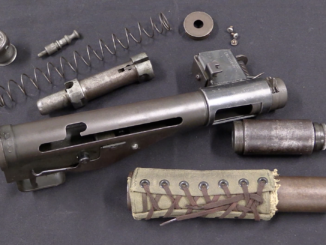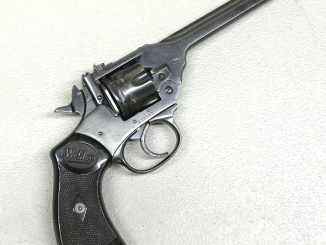The British military decided to organize their disparate small units of riflemen into a single standardized group in 1800. The 95th Regiment – the British Rifle Corps – was founded and it was equipped with a pattern of rifle designed by one Ezekiel Baker. This was a .625 caliber rifle with a 30” long barrel and a remarkably slow 1:120” rifling twist. That rifling was deliberately chosen to balance rifle accuracy with ease of loading and it worked quite well as a compromise solution. The Baker was considered effective on individual targets to 200 yards (300 with a particular skilled marksman) and area targets out to 500 yards.
The Baker was used throughout the Napoleonic Wars and only replaced in 1838 by the Brunswick rifle. This example is one of the original 1800 pattern, modified in 1815 to replace its distinctive bayonet bar (used to fit the large short sword bayonet made for the Baker) with a typical socket bayonet lug.
BritishMuzzleLoaders playlist on the Baker: https://www.youtube.com/watch?v=fv4fS-XyBhw&list=PLkOVIw4NSWVKU3jek8tGyCDBW_yzFw8t3




The brass ramrod holders are commonly known as thimbles on most muzzleloading rifles.
“(…)Ezekiel Baker(…)”
He also published Twenty-three Years Practice and Observations with Rifle Guns describing said fire-arm. It is available at https://archive.org/details/twentythreeyear00bakegoog
Interestingly Baker supported firing whilst lying belly-up (see page 34)
This is the type of rifle used by the famous fictional character Richard Sharpe in the Sharpe’s Rifles series of books and television shows.
The Royal Marines took one look at the two-groove Brunswick and, horrified, had their Bakers percussion-converted instead.
They stuck with them until the Pattern 1853 Enfield came along.
clear ether
eon
They lived in horror for a decade and more? The Brunswick adoption was 1800;percussion cap was invented 1814. Joshua Shaw if memory serves.
Keep in mind that the percussion principle dated to 1814, with Dominie Forsyth’s “scent bottle lock”, but the British Army didn’t adopt it until the 1830s, with Shaw’s copper percussion cap.
Before that it was mainly a commercial thing, used by sportsmen, which was after all what Forsyth and Shaw, both avid duck hunters, had in mind to begin with. They were initially less interested in altering the shape of warfare than they were in having a nice roast duck for Sunday dinner.
The Brunswick entered service about the same time the British Army began transitioning from flintlock to percussion cap (1835-38). Exactly why they chose the two-groove Brunswick, often called by actual experts the most inaccurate so-called “rifle” ever conceived, is one of the many aberrations of British arms procurement that will probably never be adequately explained.
cheers
eon
The 95th gets all the press, but the 60th Foot /Royal American (later King’s Royal Rifle Corps) was the first British army rifle armed regiment.
Off-topic, but…
I think I called this first, here:
https://www.forgottenweapons.com/sigs-real-p320-problem-is-no-longer-uncommanded-discharges/#comment-4791968
What I called:
https://instapundit.com/737619/
My money is on epic low-level junior enlisted shenanigans and a very badly executed coverup by the immediately involved, who all thought they were the firstest ever to come up with junior enlisted folly.
After awhile, it’s like parent’s sixth sense for their kids lying to them; you just know, as soon as you hear the first line of BS come out of their mouths. Something about this incident just triggered every one of my “That don’t sound right…” senses. Couldn’t tell you what, but it just did. Had this happened under my purview when I was still on active duty, I’d have dug and dug, pulling at the threads until it either convinced me of the unlikely truth, or I’d have unraveled the whole sweater of lies, one way or another.
Lay you long odds that there was someone there in the chain of command who had the same sense of “This is BS…” and started digging. The whole safety-of-use thing may well have been an investigators ploy. Or, alternatively, there’s an unlikely possibility that the folks at SIG-Sauer are fiendishly clever and this whole thing is meant to cover their asses, with some poor patsy playing fall guy…
I doubt it, though. Junior enlisted stupidity, more than likely. Perhaps coupled with some mid-level attempts at ass-covering due to “failure to supervise”, one of my very favorite features of military jurisprudence…
I recall you indeed called it and kudos to you. I was going to question putting it here, but this way it gets noticed by more.
I bet Rob of Britishmuzzeloaders is drooling while watching this video.